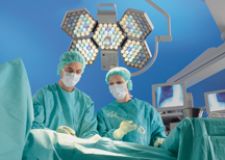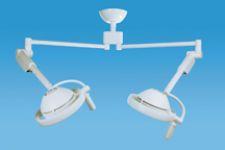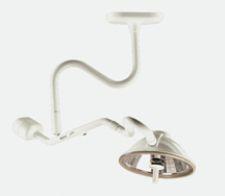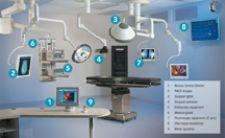
Waldmann Lighting Co.
Remarkable technological advances in materials and energy sources have revolutionized surgical and exam lighting, and the outpatient care arena is beginning to reap the benefits.
It wasn’t long ago that surgeons and office-based physicians labored under clumsy, excessively hot incandescent light domes. But today, sophisticated systems use newer energy sources such as halogen (quartz and tungsten), gas mixtures such as xenon plasma and the newest – light-emitting diodes (LEDs).
“While it would be expected that hospital [operating rooms] would receive the largest benefit of these innovations due to the typical budget for surgical lights, outpatient facilities now have improved choices for better illumination as well,” Judy Thomas, medical marketing manager for Wheeling, IL-based Waldmann Lighting Co., told Outpatient Care Technology. “In the past, choices for physician exam and office lighting were limited to hot, antiquated-looking products, but now, outpatient facilities have better choices for lights with more modern design and cooler operation.”
LEDs, for instance, are growing in popularity for their longevity and their ability to provide more light with less heat, so much so that many LED systems require minimal on-board cooling.
“Surgical lighting is really in the midst of a radical technical transformation,” said Chris Walters, product manager for Mentor, OH-based STERIS Corp. “Lighting technology is beginning to change from halogen or xenon lamps to LED arrays, which promise the benefits of dramatically increased life, reduced energy consumption and cooler operating temperatures.” While most of the development with LEDs has been in surgical lighting, Walters predicted that the technology would rapidly move into exam lighting as well.
Thomas added that such new energy sources offer improvements in bulb life, efficiency and intensity and have provided more choices in performance as well as design to those facilities searching for better lighting products.
Because surgical and exam lighting systems today are lighter, mobile and more versatile, outpatient care facilities are finding they can be used for a variety of applications. Some exam lights on the market today, for example, can easily be used in such procedures as cosmetic surgery.
“Improvements in both light management and suspension design have created a new generation of lights that are both significantly brighter and easier to maneuver than the lights of the recent past,” said Alan Campbell, product manager, Chromophare Surgical Lighting Systems, Berchtold Corp., Charleston, SC. “Gone are the days when lights had to be huge to be powerful. Today, lightweight maneuverable lights provide greater intensity levels than even the largest surgical lights of 10 years ago.”
Thomas concurred. “Lights today are more compact, and there is no need, especially in outpatient facilities, for the large, hot and clumsy reflector units of the past,” she noted, adding that medical lights can now be designed in more compact housings, which in turn allow lighter, longer and more responsive arm systems.
Lighting systems today also offer users the ability to change light output (measured in “lux”), color temperature (measured in “Kelvin”), and even compensate for shadows in the operating or exam field.
Newer generations of software-based “smart” lighting systems allow lighting systems to be customized for specific procedures and can anticipate the needs of clinicians by automatically adjusting pre-set parameters. Such advancements have led to the ability of lighting systems to integrate with C-arms, cameras and patient monitoring equipment, as well as video monitoring systems, better facilitating visual imaging and recording.
“With more minimally invasive procedures being performed today, video integration is becoming inextricably intertwined with surgical lighting,” Walters said. “Customers now want to route video signals from various places into the OR.” Since many video monitors are attached to the lighting suspension, cable capacity and flexibility of the suspension system are now as important as the light itself, Walters says, adding that new pre-wired suspension systems include fiber optic cables in addition to traditional coaxial cables, giving clinicians unprecedented flexibility in choosing which monitor type best fits their application.
What Buyers Want
Given all of the technological advancements in energy sources, heat and shadow control, outpatient buyers focus heavily on value – getting the best performance at the right cost, according to manufacturers with whom OPCT spoke.
“Outpatient care buyers are looking for best value in surgical lights. Good brightness, good mobility, and durable construction are all musts for a product that will hang from the ceiling for 10-15 years,” Campbell said. “Outpatient ORs are smaller and feature lower ceilings than their major hospital counterparts, so lights must also be compact and installed in a process that maximizes the available space.”
Added Walters, “Outpatient care buyers are primarily looking for value in the overall cost of ownership, as well as flexibility in their surgical lighting. They typically don’t have a biomedical staff to repair equipment, so they need a durable, high-quality light that requires minimal maintenance.”
According to Dave Rector, director of Marketing for Charleston, SC-based TRUMPF Medical Systems Inc., outpatient and ambulatory centers more likely choose smaller light heads with greater mobility because lower costs are important. Rector said outpatient facilities “generally don’t need the higher-end lighting systems,” spending in the range of $16,000 to $20,000.
“Outpatient buyers are looking for high performance and attractive price points and multitasking is big,” added Tom Treon, product manager, Medical Procedure Products, for Versailles, OH-based Midmark Corp.
That said, however, buyers still seek systems with the latest features to keep their physicians happy.
“Outpatient buyers are looking for lights that are cool and provide uniform and homogenous light,” said Thomas Peterson, vice president of Erie, PA-based Nuvo Inc. “Low heat generation is a big feature. The idea is to get the volume of light you need with the correct color and low heat output.” Peterson said controllable light output features also are important because they allow clinicians to adjust the intensity and color of light for various procedures. Deep cavity illumination, for example, requires warmer and more focused light output.
While cost is important, buyers are willing to pay more for systems that last a long time and require minimal service, Thomas said. “Healthcare facilities usually are aware that better products may be priced a little higher, but will be more cost-effective long-term due to reliability, steady performance over time and technical support. The last thing outpatient care facilities should want is a storeroom full of nonfunctioning gooseneck lights.”
Treon agreed. “Service is a big feature among outpatient buyers. Facilities are looking for products that are maintenance free, or come with an established service network,” he said.
Thomas added that outpatient care buyers are looking for “top reliability from a manufacturer compliant to global standards for workmanship and product function. Not only are they concerned about the quantity of light, but things like the quality of illumination, low heat and superior mechanical design are surfacing as primary factors in decision-making.”
Manufacturers cautioned buyers to work more closely with clinicians when evaluating new surgical and exam lighting systems. “Purchasing people should survey users about their needs, expectations, and understand their (facility’s) procedure mix,” Treon advised. “A lot of facilities who aren’t doing this may be buying more features than they need.” This is especially critical in renovation projects or new construction, according to Campbell. “Light manufacturers must be able to consult with all players in the construction/renovation process to make sure that new OR designs work well for all user groups.
Lag in Innovation?
With all the remarkable advances that have occurred in the lighting industry the past few years, many manufacturers are surprisingly frank in their assertions that much work still needs to be done.
“I really don’t see any recent innovations that have significantly improved the quality of light significantly,” Peterson said. “Optical quality also hasn’t improved much in recent years, even with newer light sources and recent innovations, which have done little to improve things such as color rendering or patterns.”
Peterson added that he believes some of the new lighting systems on the market “aren’t really improving on light patterns, which need to be uniform with no cold or hot spots.” While Nuvo is “always looking at new sources of energy … we wouldn’t be satisfied coming out with a new lighting system unless it improves upon what we already have,” he said. “The bottom line is that innovation must focus on improvements that benefit the surgeon or doctor.”
It’s not surprising that some nonLED lighting system manufacturers are reserved in their assessment of the use of LEDs in surgical and exam systems. “LEDs are very big right now because they boast longer life,” Treon said. “But really, we’re finding that LEDs are far from producing the quality of light that halogen provides.”
Noted Peterson: “Four or five companies now provide LED systems, but we don’t really see an advantage in LEDs from the user’s perspective. We always want to improve upon what we have, but the LED currently provides no measurable advantage over tungsten halogen.”
But Rector strongly disagreed. “There’s some dissatisfaction in the industry based on physician preference on the current quality and mobility of lighting systems,” he said, noting that TRUMPF pioneered LED lighting in the medical market several ago following a “significant” research and development process that led to the introduction of its iLED line. In fact, the company’s iLED 5 surgical light was given the “Best in Show” and “Architect’s Choice” awards last year at the 19th Annual Healthcare Facilities Symposium & Expo.
New UL Standards Improve Safety, Increase Costs
One notable recent regulatory development – the new International Electrotechnical Commission (IEC) performance standards – is a double-edged sword for lighting system buyers.
In 2005, Underwriters Laboratories (UL) adopted the more stringent standards for defining a medical light for “diagnostic,” “minor surgery” or “major surgery.” Thomas said the change means that all new medical lights must pass specific performance criteria and meet higher safety standards than in the past. So if a healthcare facility requires lights for minor surgery, they should specify products meeting standards for this application – rather than settling for lights that only meet the less stringent diagnostic category, she added.
“This standardization should result in less exposure to liability and improve patient outcome,” Thomas said, noting that some medical lights on the U.S. market have not yet been tested to the new UL standards.
Furthermore, Thomas indicated she expects many outpatient facilities will replace their old hot floor stand goosenecks with more intense, cooler and efficient exam lights. “For outpatient surgeons, we would expect a higher percentage will require lights in the ‘Minor Surgery’ category, rather than just continue using ‘Diagnostic Lights for Minor Surgery’ applications,” she said. “We also expect facilities will increasingly choose new higher intensity ‘Minor Surgery’ lights over old OR-type lights for many types of outpatient surgery.”
While welcomed by U.S. manufacturers, the new standards will undoubtedly raise the price of many lighting systems.
“Regulations may be driving up the cost of lights, but they also keep marginal companies out of the marketplace and increase patient safety,” Peterson admitted.
Treon said adoption of the new IEC standards gave a slight advantage to companies already marketing their products in Europe because those standards have been in effect there for several years. “They also have forced U.S. manufacturers to take safety to a new and higher level. They won’t stop innovation, but product costs will continue going up,” he added.
Future Innovations
LEDs, despite their perceived limitations among some observers, will have a prominent place in future exam lighting systems.
Rector said he firmly believes LEDs will penetrate the outpatient exam light market more and more. “With small facilities, the LEDs’ long lifespan will prove beneficial.” In fact, TRUMPF is preparing for this change and will unveil a three-pod iLED (for 2007-2008 launch) at this year’s Association of periOperative Registered Nurses (AORN) Annual Congress, March 13-15, in Orlando, FL.
“LEDs may have a place in exam lighting in the future, but halogen will continue being dominant in surgical lighting,” Treon noted. “LEDs may get big if manufacturers are able to increase the quality of light they produce and get them in the price range buyers want. Their biggest advantage right now is low heat generation, but not necessarily quality of light. If LEDs are improved in terms of high performance, they may be the biggest innovation to come.”
Thomas said she expects continuing evolution in bulb technology to provide the largest impact on product design over the next five years, and that advances in arm systems will enable better application and use of lights during diagnosis and procedures. “While the use of mobile floor stand lights in the outpatient sector will not disappear, more and more facilities will want to mount lights on the wall, ceiling or other equipment to improve efficiency. Eliminating the need for moving lights from one room to the other will result in higher productivity and better patient care,” she said.
“Using LEDs, manufacturers will have a lot more flexibility in the form exam lighting can take,” Walters added. “This would allow exam lighting to be mounted to equipment booms, patient beds or flush mounted into the ceiling to eliminate obtrusive suspension systems.”
Campbell said continued improvements in the performance and cost of image management will have a major impact on surgical light combinations, with larger flat screens, improved in-light cameras, and more options to combine different types of products in combination on the ceiling. “The technology of light generation itself will evolve, though the increased cost of new technology will probably keep it out of the surgery center for the near future.”
Peterson said digital processors are expanding light capabilities significantly, and increasing advancements in smart lighting systems “will allow clinicians to make adjustments on the fly in nanoseconds.”




